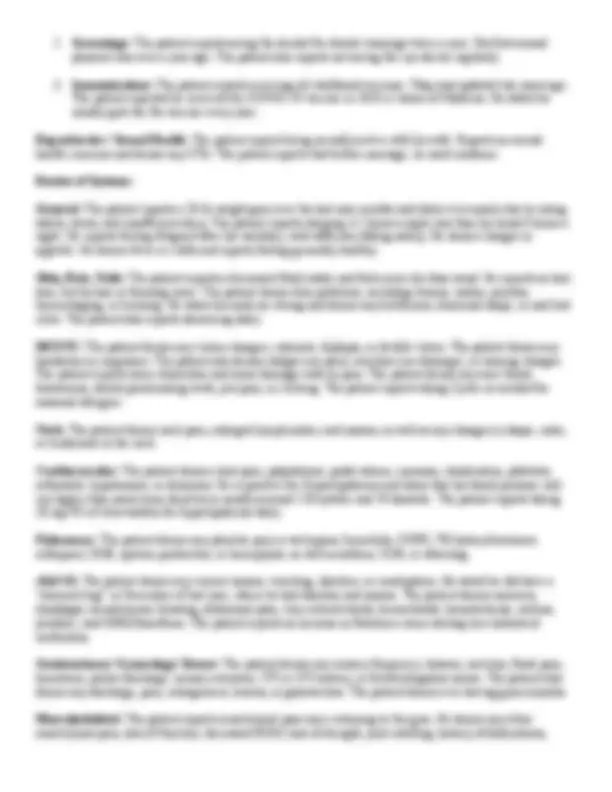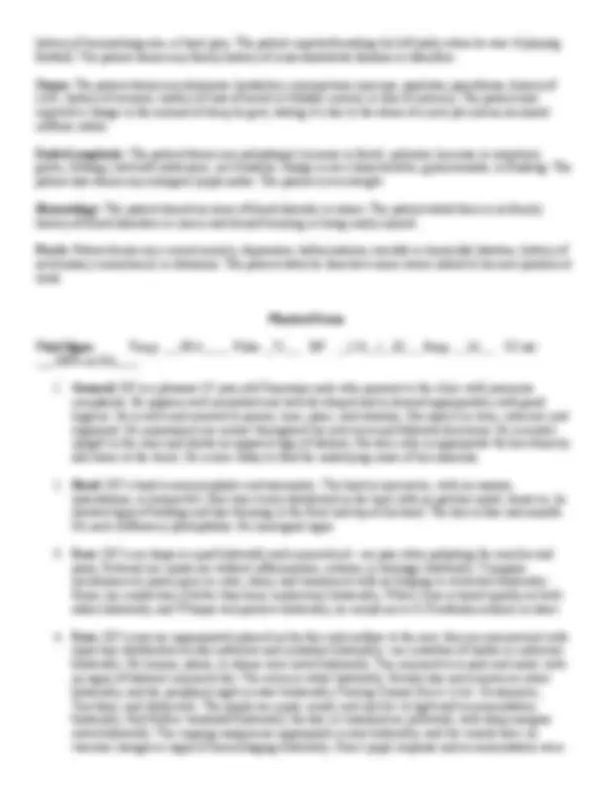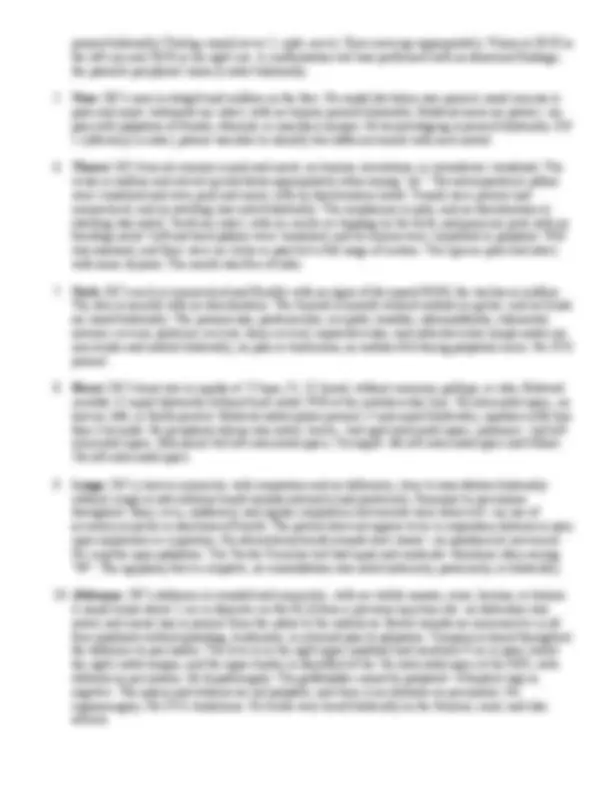





Study with the several resources on Docsity

Earn points by helping other students or get them with a premium plan


Prepare for your exams
Study with the several resources on Docsity

Earn points to download
Earn points by helping other students or get them with a premium plan
Community
Ask the community for help and clear up your study doubts
Discover the best universities in your country according to Docsity users
Free resources
Download our free guides on studying techniques, anxiety management strategies, and thesis advice from Docsity tutors
Northern Kentucky University MSN 610: Diagnostic Reasoning and Advanced Physical Assessment Comprehensive History & Physical Exam (Answered 2025) A+
Typology: Assignments
1 / 7

This page cannot be seen from the preview
Don't miss anything!




Northern Kentucky University MSN 610: Diagnostic Reasoning and Advanced Physical Assessment Comprehensive History & Physical Exam DEMOGRAPHICS Providers Name: Student NP Patient’s Initials: (Data Source ) DC Date of Exam: 16/202 5 Patient’s DOB/AGE: 10/08/1988 35 Chief Complaint: Insomnia Gender/Sexual Orientation : _Male/Heterosexual History of Present Illness: The patient is a 35 - year-old Caucasian male who had trouble sleeping over the last few weeks. He states he has difficulty falling asleep and staying asleep, especially during the work week. The patient has a history of Hyperlipidemia and denies any other pre-existing conditions, illnesses, or symptoms that prompted this visit. The patient states he does have seasonal allergies. Past Medical History: Active Problems : Hyperlipidemia, Dehydration, Seasonal Allergies, Insomnia Resolved Problems / Childhood illnesses: Unknown Previous Hospitalizations/Accidents/Injuries: The patient states he broke his left pinky at 16 years old playing football. Surgical History: The patient denies any previous surgical history. Allergies: The patient reports seasonal allergies and no known food or medication allergies. Current Medications (including OTC) : One-a-day men’s vitamin one tablet PO daily, last taken was this morning. Triple Omega fish oil is one capsule PO daily; the last taken was this morning. Zyrtec as needed for seasonal allergies one tablet PO daily as needed; last taken was two days ago. Atorvastatin 20mg, one tablet PO daily; last taken was last night. Social History : Living Arrangements: The patient lives in a two-story home with his wife and child. Marital Status/children: Married with one child who is four years old and autistic. Occupation/Education: Doctorate in pharmacy
Environmental Safety : The patient states his house has smoke and carbon dioxide detectors, a fire extinguisher, and a fire escape plan for his house. The patient reports no exposure to hazardous drugs/chemicals at work or home and adheres to all safety protocols in the workplace. The patient reports wearing his seatbelt and does not text and drive. Smoking: Denies ever smoking. Alcohol: The patient reports occasional alcohol consumption after work on Fridays. The patient reports drinking 2 oz glasses of bourbon. The patient reports typically drinking 2-3 glasses on Fridays. Drugs: Denies any illicit drug use Diet: The patient reports trying to follow a low-fat diet due to his recently diagnosed high cholesterol. Caffeine intake: The patient reports increased caffeine intake and drinking 2 - 3 cups of coffee in the mornings and 1-2 sodas in the afternoon. His total caffeine intake is around 200-300mg. Lifestyle/Activity level : As of two weeks ago, the patient reports being more active and starting to go to the gym 2-3 times a week for at least an hour. The patient also reports golfing most weekends to de-stress from work. Hobbies / Sports / Leisure activities: The patient reports golfing on the weekends. Other Non-Prescribed Drugs: Patient states taking OTC Zyrtec, omega 3, and a men's multivitamin. Family History: Relationship Living^ or Deceased Age Illnesses Mother Living 62 Hypothyroidism Father Living 65 Unknown Paternal Father Deceased 88 Hypertension, Hyperlipidemia Paternal Mother Deceased 86 Unknown Maternal Father Deceased 83 Unknown Maternal Mother Deceased 52 Unknown Preventative Health/ Anticipatory Guidance: (Age Appropriate)
history of trauma/surgeries, or back pain. The patient reported breaking his left pinky when he was 16 playing football. The patient denies any family history of musculoskeletal diseases or disorders. Neuro: The patient denies any dizziness, headaches, syncope/near-syncope, paralysis, paresthesia, history of LOC, history of seizures, history of loss of bowel or bladder control, or loss of memory. The patient also reported a change in the amount of sleep he gets, stating it’s due to the stress of a new job and an increased caffeine intake. Endo/Lymphatic: The patient denies any polyphagia (increase in thirst), polyuria (increase in urination), goiter, lethargy, hot/cold intolerance, nervousness, change in sex characteristics, gynecomastia, or flushing. The patient also denies any enlarged lymph nodes. The patient is overweight. Hematology: The patient denied an issue of blood disorder or issues. The patient stated there is no family history of blood disorders or cancer and denied bruising or being easily injured. Psych: Patient denies any current anxiety, depression, hallucinations, suicidal or homicidal ideation, history of involuntary commitment, or delusions. The patient states he does have some stress related to his new position at work. Physical Exam Vital Signs: Temp: 98.4 Pulse: _ 100% on RA BP: 124 / 82 Resp: 16 O2 sat:
present bilaterally (Testing cranial never 2 - optic nerve). Eyes converge appropriately. Vision is 20/20 in the left eye and 20/20 in the right eye. A confrontation test was performed with no abnormal findings; the patient's peripheral vision is intact bilaterally.
c. Cognitive Function: Cognition intact with the mini cognitive exam. The patient is alert and orientated to the person, place, time, and situation. The patient accurately stated his telephone number, age, date of birth, and current US president. The patient correctly identified three words given immediately after (Red, White, and Blue) and recalled the same three words later. The patient accurately stated numbers serial 7s back from 100. Patient able to accurately draw a clock put the numbers in a circle, and then correctly "set the time" to 3: Assessment Statement: A 35-year-old Caucasian male presents to the clinic with a new onset of insomnia. The patient is noted to have a history of hyperlipidemia. The patient states he has been told that his cholesterol has been high previously but stated he did start the new diet recommended last month. The patient also states that his diet is not very consistent due to a new job and stress. I have encouraged the patient to start a low-fat diet, eat healthy fats, and promote less fast-food intake. Additionally, I educated the patient that an adult should ideally get 150 minutes of aerobic exercise a week. The patient is encouraged to walk for 20 minutes daily and slowly increase the time and pace. I educated the patient on risk factors associated with obesity, such as an increased risk of diabetes, hypertension, and heart disease. Additionally, I recommend decreasing caffeine intake to half of his usual 200-300mg; both can impact sleep. Furthermore, I educated him on increasing his fluid intake, specifically water or drinks with electrolytes, to help rehydrate his skin. Recommend follow-up in 2 - 3 weeks. Problem List (Minimum of 3 required) Include ICD – 10 codes